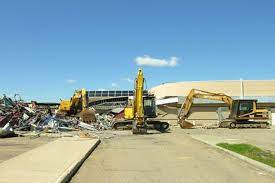The Step-by-Step Process of Demolishing a House

The Step-by-Step Process of Demolishing a House
Introduction:
Demolishing a house is a complex process that requires careful planning, adherence to safety regulations, and the use of specialized equipment. Whether it's to make way for new construction, remove a dilapidated structure, or address safety concerns, the demolition process must be executed methodically to minimize risks and ensure efficiency. In this comprehensive guide, we'll explore the step-by-step process of demolishing a house, from initial preparation to final site cleanup, providing insights into each stage and highlighting key considerations along the way.
Step 1: Pre-Demolition Planning
-
Obtain Necessary Permits: Before any demolition work can commence, it's crucial to obtain the necessary permits from local authorities. Permit requirements vary depending on location and the scope of the demolition project. Working without the proper permits can result in fines, delays, and legal complications, so it's essential to ensure compliance with all regulatory requirements.
-
Conduct Site Assessment: A thorough site assessment is conducted to evaluate the condition of the structure, identify any potential hazards, and determine the most suitable demolition methods. Factors such as the presence of hazardous materials, proximity to neighboring structures, and accessibility of the site are carefully considered during this phase.
-
Develop a Demolition Plan: Based on the site assessment, a detailed demolition plan is developed outlining the sequence of work, safety protocols, equipment requirements, and waste disposal procedures. The plan should also include provisions for environmental protection, such as dust control measures and erosion prevention.
Step 2: Hazardous Material Removal
-
Asbestos Abatement: If the house contains asbestos-containing materials (ACMs), such as insulation, floor tiles, or roofing shingles, specialized contractors are hired to safely remove and dispose of these hazardous materials. Asbestos abatement must be conducted in accordance with regulatory guidelines to prevent exposure and contamination.
-
Lead Paint Removal: Similarly, if the house contains lead-based paint, proper procedures must be followed to remove and dispose of it safely. Lead paint removal may involve containment measures to prevent lead dust from spreading and exposing workers or the environment.
-
Other Hazardous Materials: In addition to asbestos and lead, other hazardous materials such as mold, mercury, or PCBs (polychlorinated biphenyls) may also be present in older structures. These materials must be identified and addressed appropriately to ensure worker safety and environmental compliance.
Step 3: Structural Demolition
-
Select Demolition Method: The method of demolition is chosen based on factors such as the size and condition of the structure, site constraints, and environmental considerations. Common methods include mechanical demolition using excavators or bulldozers, manual demolition using handheld tools, and controlled demolition using explosives or wrecking balls.
-
Structural Dismantling: Demolition crews begin by removing any salvageable materials, such as doors, windows, fixtures, and appliances, for recycling or reuse. Then, they systematically dismantle the structure, starting from the top and working their way down to the foundation. Heavy machinery is used to demolish walls, floors, and roofs, while handheld tools are employed for precision work in tight spaces.
-
Waste Management: Demolition debris is sorted and separated on-site to facilitate recycling and disposal. Materials such as concrete, brick, wood, and metal are typically recycled or repurposed, while non-recyclable waste is transported to approved landfills. Proper waste management practices help minimize environmental impact and reduce disposal costs.
Step 4: Site Cleanup and Restoration
-
Debris Removal: Once the structure has been demolished, debris is cleared from the site using trucks or dumpsters. Care is taken to ensure thorough cleanup, including the removal of any remaining debris, nails, and other hazards.
-
Site Grading and Preparation: The site is graded and leveled to prepare for future development or landscaping. Any remaining foundations, footings, or underground utilities are removed or capped as necessary.
-
Environmental Remediation: If soil or groundwater contamination is detected during the demolition process, remediation measures may be required to mitigate environmental impacts. This may involve soil excavation, groundwater treatment, or the installation of barriers to prevent contamination spread.
-
Final Inspection and Certification: Before the project is considered complete, a final inspection is conducted to ensure that all demolition work has been carried out according to the approved plan and regulatory requirements. Once satisfied, the site is certified as safe for future use or development.
Conclusion:
Demolishing a house is a multifaceted process that involves careful planning, skilled execution, and compliance with regulatory requirements. From pre-demolition planning and hazardous material removal to structural demolition and site cleanup, each step plays a crucial role in ensuring the safe and efficient completion of the project. By following the step-by-step process outlined in this guide and working with experienced professionals, property owners can navigate the demolition process with confidence, knowing that their project is in capable hands.
